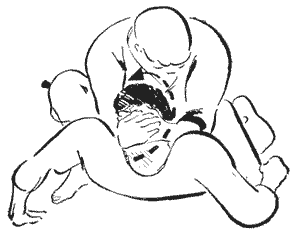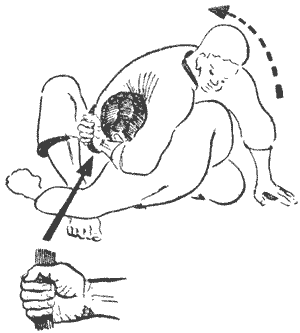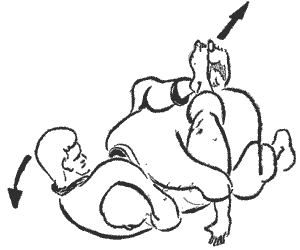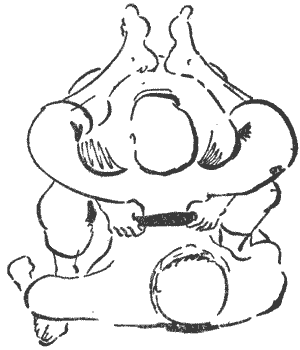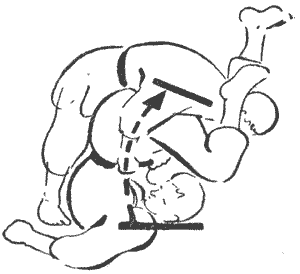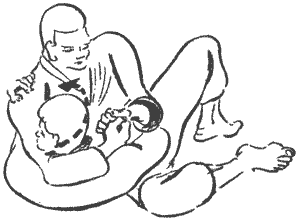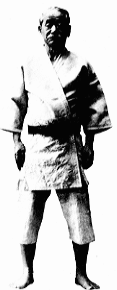 | by Mikunosuke KawaishiThe OBJECT of the Dislocation Necklocks is to bring about a dislocation of the cervical vertebrae. The attacks with dislocation NECKLOCKS often afford TORI an opportunity, if he knows how to turn to his advantage the various styles of UKE’S resistance, to link up in a Strangulation and above all in an Armlock. Thus the Dislocation Necklocks are used a great deal against one who resists “tortoise-like”, arms bent and head drawn into the shoulders, because they compel him in order to escape therefrom either to turn his head or more or less to stretch his arms. Attention: All these holds can be very DANGEROUS and should be taught only from the grade of Brown Belt. In fact, if their execution is too rough, too rapid or carried too far, they incur the risk of causing serious injuries the consequences of which may be grave and permanent, arising from the dislocation of the cervical vertebrae (through elongation or torsion) to the point of fracture of the spinal column through rupture of the intervertebral cartilaginous discs. The utmost prudence must therefore be impressed upon those practising these methods. TORI should always be careful to preserve his balance during the entire execution of the move- ment which should be progressive and without discontinuity in order never to be obliged abruptly to take a supplementary and an unforseen point of support on UKE’S neck. As for UKE, he must try to discipline his efforts to dodge and escape by placing at the right moment his shoulders, arms and legs as points of support. 1. KUBI-HISHIGI, Dislocation of Neck Tori, seated well balanced and stable on uke’s stomach, his left leg in support behind and his right foot in front, against uke’s left flank under his armpit, executes a double movement with his arms of traction of the nape of uke’s neck upwards and of torsion of his head towards his left, i.e. appreciably in the direction of tori’s raised right knee. The double movement of traction and torsion is accomplished with the participation of tori’s entire upper body with the contracted abdominal muscles as base. 2. OSAE-HISHIGI, Dislocation in Immobilization Uke’s head is thus wedged underneath tori’s right armpit. Tori’s hold on his own belt must be taken as far back as possible, the role of his right arm not being to contract, all the more as his position, elbow in front, does not lend itself to an effort but is simply to form a cravat or collar as taut as possible and so render it impossible for uke to extricate his head. All that tori now has to do as he presses on his left arm is to bend backwards towards his right. If in spite of everything uke succeeds in driving tori’s right foot forward with his left arm or in pushing back tori’s left knee with his right arm to cause tori to roll to his left, tori completes the Necklock by subjecting uke to the 18th Strangulation (Do-Jime) and bends himself backwards. The role of the body scissors consists simply in furnishing tori with a point of support so that he may be able to bend backwards whilst still holding uke. 3. TATE-HISHIGI, Standing Dislocation 4. GYAKU-HISHIGI, Dislocation by Elongation Remark: Practically it is quite difficult to distinguish these two kinds of holds in their actual execution during a contest since in fact there is always a partial Strangulation and a partial Dislocation of the neck. The two movements are complementary. 5. TOMOE-HISHIGI, Dislocation in Circle At this moment tori overturns uke backward by pushing uke’s loins with his stomach and tugs strongly on his own arms so as to press with all his weight on the back of uke’s thighs which overhang uke’s head. Uke’s chin is then blocked against his sternum. The method of this Necklock is the reverse of the others in the sense that here it is not uke’s head that moves, his body being kept immobile, but the opposite, since his head is blocked by the ground and his own shoulders, and tori makes his body topple over backwards from on top. Attention: In this Necklock more particularly tori’s equilibrium is slightly more uncertain than in the others. There is a period of “floating” before the hold is definitely ensured; at that moment tori may be unbalanced by uke who will wrongly support on his neck a double weight or else uke may try to pivot to the right or to the left. It is on these occasions that accidents are likely to happen. 6. KESA-GATAME-KUBI-HISHIGI, Dislocation of Neck in Scarf Hold Tori then continues his combined effort with both arms from his right towards his left and completes this lateral rotation by bending backwards in order to lift uke’s head. There are thus at one and the same time torsion and elongation of the vertebrae. Remark: The centre of gravity of tori’s efforts is here still his abdomen.
| |
“The man who is at the peak of his success, and the man who has just failed are in exactly the same position. Each must decide what he will do next.” | ||

